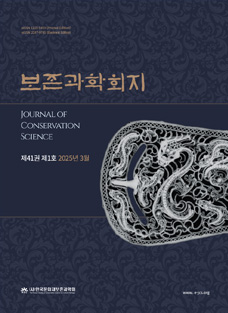Journal of Conservation Science Vol.28 No.1 pp.7-20
천안 쌍용동 용암유적 출토 조선시대 토기의 재료과학적 특성과 원료의 산지해석
Material Characteristics and Clay Source Interpretation of Joseon (the 15th to 17th Century) Potteries from Ssangyongdong Yongam Site in Cheonan, Korea
Ran Hee Kim,Chan Hee Lee,Jung Hyun Yun
Abstract
This study was to identify the material characteristics and provenance of the Joseon (the 15th to 17th century) potteries from Ssangyongdong Yongam site in Cheonan. The pottery samples of the kilns and the workshops (habitation) from the study area have grey or red color with similar matrix but various shapes and different hardness, according to firing temperature. All of the pottery and the workshop soils were very similar patterns with characteristics of occurrences, mineralogy and geochemical evolution trend. But soils from around the site does not correspond with them. So the workshop soil that the fine clay is raw clay for making pottery in Yongam site. Firing temperature of soft-type potteries were presumed to be formed around 900℃ based on phase transition of clay minerals and mica. Hard-type pottery, mullite was detected and plagioclase was not detected by X-ray diffraction analysis, which means that potteries had experienced firing between 1,000 to 1,100℃.

 E-Submission
E-Submission 
 E-Submission
E-Submission 
![]() Journal Search Engine
Journal Search Engine




 KSC
KSC